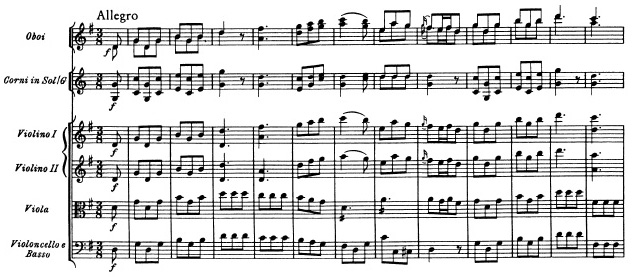Wolfgang Amadeus Mozart
Symphony No.17 in G major, K.129
Media Review / Comparison
2016-02-14 — Original posting
2016-09-22 — Brushed up for better readability
Table of Contents
Introduction / The Recordings
This posting is about the Symphony No.17 in G major, K.129, by Wolfgang Amadeus Mozart (1756 – 1791), of which I currently have two recordings:
- Christopher Hogwood / The Academy of Ancient Music (1981)
- Jaap ter Linden / Mozart Akademie Amsterdam (2001)
Both these recordings are recent acquisitions on CD. In my LP collection, I only had Karl Böhm’s complete Mozart symphony recording, and I’m not particularly eager to listen to that again…
This mini-comparison is a by-product of my preparations for reviewing a recent concert at the Tonhalle in Zurich.
Background, About the Composition
Wolfgang Amadeus Mozart (1756 – 1791) wrote this symphony in 1772, aged 16. It is part of a group of 6 symphonies: K.128 (C major), K.129 (G major), K.130 (F major), K.132 (E♭ major), K.133 (D major), and K.134 (A major). Mozart’s biographers now think that the composer wanted to present a representative collection of symphonies to his new employer, Count Colloredo (Prince-Archbishop of Salzburg from 1771 until 1803).
The Movements
Along with the Symphony K.128, the Symphony No.17 in G major, K.129 has three movements only (the other symphonies in the group of six all have four movements):
I. Allegro (4/4)
46 + 68 bars, both parts with repeat signs
Just like the early Symphony No.5 in B♭ major, K.22, the movement starts with a simple, 4-bar theme with an ostinato accompaniment, and these 4 bars are repeated immediately:
Not just the accompaniment, but also the theme itself (certainly in its rhythmic structure) resembles that of the opening Allegro in the predecessor symphony (No.5 in B♭ major, K.22). There is a “Mannheim crescendo” (“Mannheim rocket”) in bars 31ff.
II. Andante (2/4)
30 + 43 bars, both parts with repeat signs
A calm, serene movement, almost like a serenade; the 2/4 time signature implies a faster tempo (for an Andante, with two beats per bar) than tradition may suggest:
An interesting feature is the canon-like beginning of the second part (also with repeat signs), which can be seen as 8-bar (mini-)development part in a classic sonata form:
III. Allegro (3/8)
79 + 113 bars, both parts with repeat signs
The last movement is virtuosic (for that time, of course):The two violin voices have frequent, soft (p) duet segments, accompanied by the rest of the orchestra. Having these performed by soloists seems like an obvious idea, though not directly implied in the score.
The Interpretations
Both recordings below are historically informed and were recorded on period instruments:
Christopher Hogwood / The Academy of Ancient Music
Mozart: The Symphonies
Christopher Hogwood / The Academy of Ancient Music
Decca / L’oiseau-lyre 452 496-2 (19 CDs, stereo); ℗ 1979 – 1986 / © 1997
Booklet: 127 pp. e/f/d/i

For general information see the posting “Mozart: Symphony in D, K.19“. This symphony was recorded in 1981.
I. Allegro
Duration: 6’28” (1/4 = 146)
I very good interpretation in my opinion, transparent, with good, light articulation, both repeats played. The one irritating point is that the recapitulation (the return in the first theme in the second part) is oddly faster than the development phase, making it feel rushed. And this happens also in the repeat instance, so either this is intended, or both repeats used cuts from a faster recording track. The Mannheim crescendo in bars 31ff. could be more pronounced.
II. Andante
Duration: 5’58” (1/4 = 49)
If anything, then this is an Andante in quavers, not in 2/4 time: too slow, in my opinion (making the movement feel lengthy). The use of a concertino for some of the p parts is a nice idea, though, making the movement more intimate.
III. Allegro
Duration: 4’26” (3/8 = 92)
Very nice, conclusive interpretation, good tempo selection (not rushed), the duet segments are performed by solo violins, which of course makes the coordination easier, but in this recording it seems totally appropriate, an excellent fit.
Overall Duration: 16’49”
Rating (see above for details): 4.0 (4 / 3 / 5) — To me, the biggest drawback in this recording is the tempo selection in the second movement; still, a good recording, overall.
Jaap ter Linden / Mozart Akademie Amsterdam
Mozart: Complete Symphonies
Jaap ter Linden / Mozart Akademie Amsterdam
Brilliant classics 94295 (11 CDs, stereo); © 2011
Booklet: 23 pp. English

For general information see the posting “Mozart: Symphony in D, K.19“. This symphony was recorded in 2001.
I. Allegro
Duration: 6’18” (1/4 = 150)
Good articulation, less vibrato than Hogwood’s recording, very slightly faster tempo, occasionally (in small motifs) slightly rushed. My main objection here is the lack of transparency. The Mannheim crescendo in bars 31ff. is nice, but thereafter, the main theme motifs in the violins almost drown in the sound of the orchestra.
II. Andante
Duration: 5’30” (1/4 = 55)
Definitely the better tempo than Hogwood, even though of course, the “2/4 Andante beat” is still fairly slow (but then, the fast ornaments must not be rushed). Also, the ornaments are played as such, i.e., lighter than the main melody. I really like this interpretation: excellent, in my opinion, with careful, subtle dynamic differentiation.
III. Allegro
Duration: 2’54” (3/8 = 100)
Transparency and acoustic balance are moderate, again. Also here, the duet parts are performed by soloists, though that is somewhat obscured by the reverberating soundscape. Also, the tempo is maybe a bit fast (feeling a tad pushed), causing some of the fast passages to appear slightly superficial: this is Allegro (joyful), not Presto! The second repeat is omitted (why here and not in the other movements?).
Overall Duration: 14’40”
Rating (see above for details): 4.0 (3 / 5 / 4) — Overall, on a par with Hogwood’s recording, with the second movement as highlight, but the overall sound (excess reverberation) obscuring the recording, making it less transparent.
Addendum
Mozart’s Symphony in G, K.129 was featured in a concert at the Tonhalle in Zurich, on 2016-02-02, with Richard Egarr and the Zurich Chamber Orchestra — see my concert review for Bachtrack.com. As this is in German, I have written up a separate, more extended review in the posting “Isserlis, Egarr / ZKO — Zurich, 2016-02-02“.










